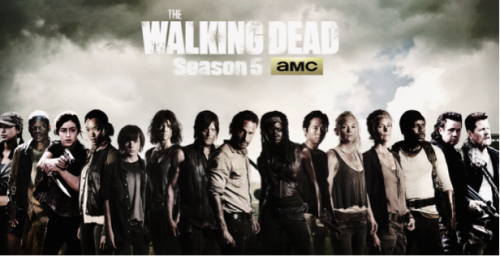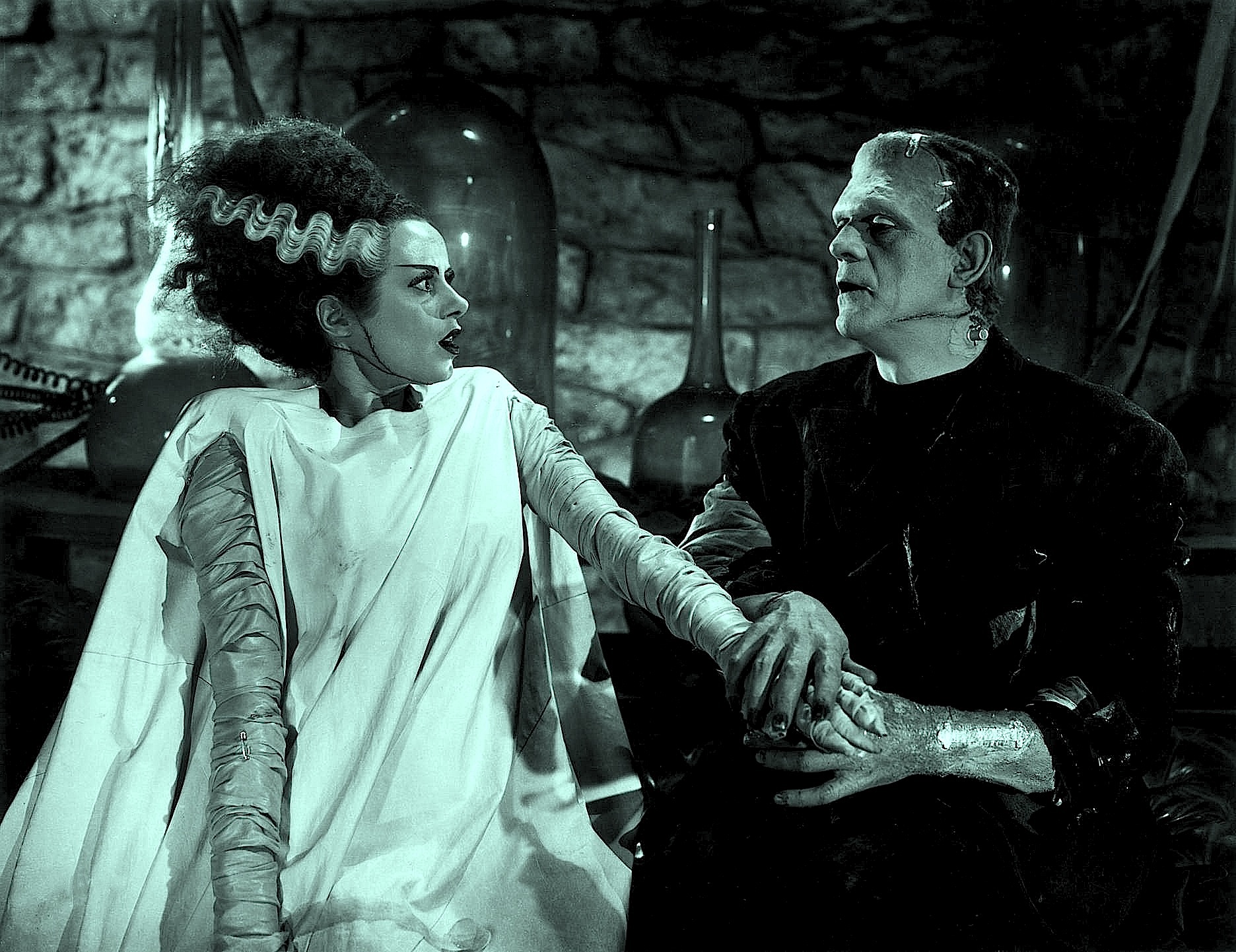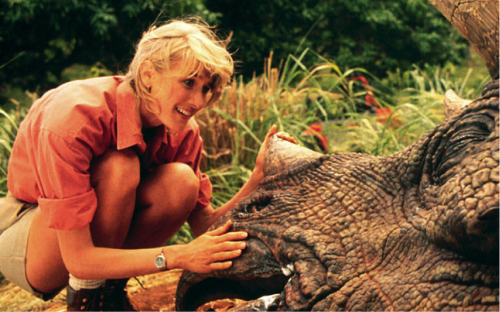Our core group of survivors in The Walking Dead season five
This guest post by Brooke Bennett appears as part of our theme week on Violent Women.
The Walking Dead has long been plagued with criticism in relation to its portrayals of gender roles (for example, see both of Megan Kearns’s posts and Rebecca Cohen’s). in addition to relegating characters of color to the background at best, killing them to further the plot surround the white characters at worst. Further, queer characters have been completely absent within the show’s first four seasons, though some have suggested that the relationship between Andrea and Michonne during season three can be read as implicitly queer. That being said, season five is very different. In summary, season five finds our group of survivors escaping from the cannibalistic community of Terminus (thanks to Carol), attempting to survive on the road, then finally coming across the community of Alexandria, which seems to be extremely well off (and not full of cannibals thankfully). This season seems to present a large change in representational issues by including complex characters of color that we actually know something about and care for, presenting the couple of Aaron and Eric from the Alexandria community and self-pronounced lesbian Tara, and doing away with the innate equation of vagina equals do the laundry while the men go kill all the zombies. All of these areas of increasingly representation are extremely important in any examination of the show, but this post will dive deeper into the specific portrayal of the “tough” women of season five.
Michonne and Carol as “tough women” in The Walking Dead season five
Carol and Michonne are definitely some of the most intriguing (and my favorite) characters during season five of The Walking Dead. First off, thinking about Carol during season one to how she has completely changed over the last five years of the show is striking. In the beginning, she was in an abusive relationship with soon-dead husband Ed. Upon his death, as Megan Kearns points out, she becomes reliant on Daryl as the group searches for her daughter, Sophia, in the second season. The third season, once again, shows Carol (and some of the other women, especially Beth) as relegated to doing all the boring domestic chores and taking care of Rick’s new daughter Judith after Lori dies in season three. Season four presents a more active role for Carol, but season five is the most crucial to her character development. In season five, Carol constructs a persona of herself for the Alexandria community, acting like she is some innocent, helpless upper-class suburban housewife. She even tells Deanna, the leader of Alexandria, that she “really didn’t have much to offer” to Rick’s group, which is obviously not true because she’s the reason they all escaped Terminus without becoming someone’s dinner.
Carol and femininity as masquerade
One of my absolute favorite scenes of season five is when Daryl is sitting on the porch of one of the fancy houses while Carol walks outside all made-up in her housewife outfit. Daryl scoffs and tells her, “You look ridiculous.” To us this is hilarious because we agree with Daryl; we know she is not this housewife type character any longer. Carol intelligently masquerades as this feminine role in order to make those in Alexandria purposely underestimate her. In essence, this dynamic also seems to point out how gender is something we do – it’s a performative activity that we have to continuously work at because it’s a socially constructed idea. Carol performs this weak embodiment of women in order to be able to sneak around the community and do as she wishes. At one point Carol even remarks to Rick, “You know what’s great about this place? I get to be invisible again.” Carol challenges the innateness of gender by not only being a extremely strong, capable female survivor, but also by masquerading as the opposite find of woman she has become now.
On the other hand, Michonne has evolved greatly as a character as well. When she was introduced in season three, Michonne was largely unresponsive to other people and seemed very confrontational. Problematically, Michonne is used as an object of trade in relation to Rick and the Governor – the Governor claims he will leave Rick and his group alone if he gives him Michonne, which Rick actually tells Merle (of all the characters, of course the most overtly racist character is chosen) to go through with this. As the show continues into season four, Michonne emerges with actual dialogue (about time) and, once again, demonstrates how she is arguably the toughest character of the entire group. We finally learn more about her backstory – she apparently has lost a child due to the zombie apocalypse which is, significantly, similar to Carol as well (I’ll return to this connection in a bit). Michonne consistently tries to convince Rick that they need to find a new community or start their own; they cannot survive by living on the road anymore. This obviously rational thinking is invoked continuously in season five, and is in stark comparison to Rick’s questionable, impulsive choices throughout season five.
Sword-wielding badass, Michonne
One of Michonne’s most crucial scenes in season five surrounds an episode later on, when the group is in Alexandria. Significantly, Deanna (the leader of Alexandria) gives both Michonne and Rick the job of constable – they are responsible for enforcing order. Obviously, Rick has always had this role both in the post-apocalypse and in his professional career choice as a cop before the apocalypse. On the other hand, Michonne being given this role provides an alternative mode of leadership, one which looks increasingly more appealing as Rick seems to be losing his ability to lead responsibly and effectively. After Carol tells Rick that she knows Pete is abusing Jessie (a married couple within Alexandria), and likely their young child Sam, Rick immediately wants to kill Pete, no questions asked. This is certainly motivated by the obvious attraction Rick has to Jessie; he’s reacting to his feelings for her and need to save the damsel in distress, hoping to make her his own. Rick and Pete end up in a physical fight that pours out into the street, with a large part of Alexandria coming to watch and attempt to break it up, which is ultimately done by Deanna. Rick, who seems to be very distraught and hysterical, yells back at Deanna and the other residents, faces bloodied, that they are not going to survive if they don’t change the way they do things.
Hysterical Rick after beating up Pete
This is probably good advice, but Rick somehow thinks that this is an excuse to go against what the society’s leader, Deanna, has told him to do (not kill Pete). Either way, Rick goes on a rant yet again about how they are all doomed and he isn’t just going to sit by and watch this community fall apart, but, in mid-sentence, Michonne comes in and hits Rick over the head, knocking him unconscious, and ending the episode. Unlike Rick, Michonne knows what he says to be true but doesn’t go about changing the group via violence and rash decision-making. Michonne is, by far, the better leader of the two. In her constable uniform, she knocks Rick out, powerfully making the connection between her embodiment of moral law enforcement that is completely in opposition with Rick’s way of doing things.
Michonne after knocking out Rick
Overall, Carol and Michonne provide the most compelling roles of “tough” women within season five of The Walking Dead. As I mentioned earlier, both women had experienced the loss of a child because of the zombie apocalypse, which deserves further analysis as it complicates their role of powerful women characters within the show. Over the show, both Carol and Michonne are presented as being a sort of maternal figure for other children. For Carol this is seen in her relationship with Lizzie and Micah, whereas Michonne is presented this way with Carl when she helps him get the family picture so that Judith will know what Lori looks like.
Michonne as maternal figure for Carl
Carol as maternal figure for Lizzie and Micah
Interestingly, tough women being shown as maternal figures is a common theme in female-centered action narratives. For example, in Kill Bill, The Bride is a brutal, unstoppable character as she takes revenge upon those who tried to kill her. Yet, in Kill Bill: Vol. 2 she finds out that her child is alive, thus reasserting her role as mother. This can be read as reminding The Bride that she can be as tough as she wants, but at the end of the day she is still biologically female and her duties should/need to revolve around the realm of domesticity. Since Carol and Michonne are presented as maternal figures within The Walking Dead, this can complicate a reading of their toughness as being completely empowering since we are reminded of their biological femaleness. Yet, Carol’s gender performance in season five would seem to argue that gender is more socially constructed than anything. In the end, the action heroines of The Walking Dead, like other “tough” heroine narratives in film and television, cannot be taken as completely, 100 percent empowering just because the women are able to take care of themselves and display how they can totally kick some ass.
Sasha and Rosita during season five of The Walking Dead
Any discussion of strong women in season five would be mistaken not to mention Rosita and Sasha. Unfortunately, these two characters are underexplored (along with Tara, as well) at this point, though they are portrayed as being strong like Michonne and Carol are. Sasha, as Rick even comments when the group reaches Alexandria, is the best shooter, leading her to get the job of being on watch and shooting zombies from a sniper tower. Rosita originally was shown being completely oversexualized when we first met her. She worn tiny shorts and a tiny top, showing off her body, and also consistently had pig tails. For the action heroine, this fetishistic presentation is super common – think Lara Croft in Tomb Raider or Alice and Jill in the Resident Evil franchise.
Oversexualized Rosita in The Walking Dead
Oversexualized Lara Croft (Angelina Jolie) in Tomb Raider
Thankfully, when the group gets to Alexandria this trope is reversed, and Rosita finally wears dons a reasonable clothing choice for the zombie apocalypse and no longer wears girlish ponytails. Other than serving a minimal role is Abraham’s sidekick, Rosita doesn’t seem to do anything else within the show. On the other hand, Sasha is a somewhat more developed character, especially in her relationship with her brother, Tyreese, and in her romantic relationship with Bob, who both die within season five – Sasha gets a pretty emotionally tough hand during the fifth season. Like Michonne, Sasha also makes some more rational and intelligent, in comparison to Rick, comments to the group. When at the welcoming dinner party, some residents ask Sasha what her favorite meal is because it would just be awful if they cooked her something else. She responds, “that is what you worry about?!” in utter shock as to the hierarchy of their priorities. Of course, Sasha is much more realistic and doesn’t buy into this cookie-cutter “fake” community of Alexandria, with its $800,000 homes (as Deanna mentions to Rick) and no longer existent lifestyle it symbolizes.
Overall, I hope Rosita and Sasha will continue to be explored an developed as season six (which just premiered Sunday, October 11 this year) progresses, alongside Tara who is also a very underutilized character within The Walking Dead. Additionally, it will be interesting to see who becomes the authoritative power in Alexandria, as the return of Morgan in the season five finale further complicates Rick’s role as authoritative leader, or the “Ricktatorship” as some critics have put it. Either way, I’m excited to see where the development of these awesome, ass-kicking tough women goes in the episodes to come.
Brooke Bennett is an undergraduate student and honors candidate majoring in English at the University of Arkansas. Her academic work revolves around horror in film and television, with an emphasis on feminist media studies, especially looking into The Walking Dead. When not in school, Brooke binge watches horror movies on Netflix and hopes to be a popular culture critic and academic in the future.




















